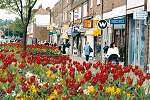Potters Bar
History

However, for several hundred years a linear settlement has existed here on the edge of Enfield Chase in the Parish of South Mimms. From medieval beginnings in the grounds of the present Morven Park House, it spread out along what became the High Street in subsequent centuries.
The name Potters Bar is thought to derive from evidence of a Roman pottery, believed to have operated in the area that is now the town's Parkfield recreation ground.
The railway station opened in August 1850 on what was then the London to Peterborough line passing between the villages of Potters Bar and South Mimms. This attracted people to live in the area and led to the building of a number of houses at the beginning of the century at the northern end of Darkes Lane.
The pressure of suburban development was at its height in the 1930s when the population of Potters Bar trebled. Light industry arrived after the Second World War and two large council estates were built in the 1950s. As a result of rapid suburban growth the town has two shopping areas centred on Darkes Lane and the High Street.
Continuing development of road and rail links, notably the M25, has enabled Potters Bar to grow into a modern town with an active community life. Today its population stands at approximately 22,000.
A recent addition to Potters Bar's heritage is the museum provided by Hertsmere Borough Council and run voluntarily by members of the Potters Bar and District Historical Society at the Wyllyotts Centre in Darkes Lane.
Although Potters Bar is set in the midst of fine countryside, those who prefer an even more rural landscape will find that nearby South Mimms has much to offer. It is probably the most ancient part of this area, mentioned in the Domesday Survey of 1086 as 'one berewick which is called Mimes'.
A Norman motte and bailey castle dating from the reign of King Stephen once occupied a site north-west of Mimms Hall. The castle is thought to have been built by the famous traveller and writer Geoffrey de Mandeville in 1141. Excavations here have disclosed the foundations of buildings including a timber keep or tower, and quantities of pottery, inscribed tiles and metalwork from the site are now in the possession of English Heritage.
St Giles Church at South Mimms was built in stages between C.1140 and 1525 and was restored by G.E. Street in 1876-77.
St Giles contains many fine monuments, notably those of the Frowyk family, Lords of the Manor of Old Ford and leading City of London goldsmiths. The churchyard contains a Doric style mausoleum C.1907 of the Cavendish-Bentinck family.